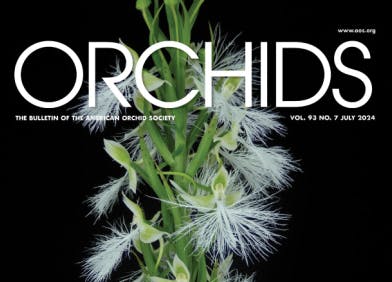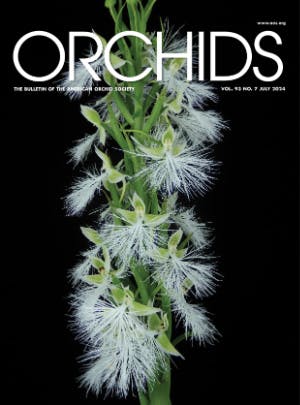
SPRINGTIME LEAF YELLOWING
The springtime brings more direct sunlight and more hours of sunlight as well as warmer temperatures, all causing the growth rate of our orchids to ramp up. Cattleyas start forming new growths and phalaenopsis grow new leaves. If you see one of the leaves on a cattleya back bulb yellowing or one of the lower leaves on a phal yellowing, it might just be natural senescence, time for that leaf to pass. The leaf will be a clear yellow, gradually losing color as nutrients are reabsorbed into the plant to be translocated to the new growths. Do not be in any hurry to remove the leaf. Let the plant reabsorb all the minerals and when the abscission layer forms, the leaf can be removed with a gentle tug.
If an inordinate number of leaves start yellowing in the spring, the plant may be sacrificing older growths to obtain the building blocks for new growths. If the plant is robbing Peter to pay Paul, you must ask yourself whether you provided enough nutrition to your plants in the previous months. One often overlooked nutrient is magnesium, an essential plant nutrient that is at the center of the chlorophyll molecule, and of course, chlorophyll is what makes your orchids green. Our water in Florida tends to be magnesium deficient and many fertilizers contain no magnesium. I have read recommendations to apply Epsom salts (magnesium sulfate) every month in megadoses of 1 tablespoon per gallon (approximately 4 ml/liter). Of course, your plants do not just grow one day a month and most of that high dosage of magnesium will be flushed through the pot. Better to apply a more diluted amount more frequently. If you are fertilizing with a 20-10-20 or 20-20- 20 fertilizer, you can add Epsom salts to your fertilizer solution in an amount equal to the amount of fertilizer you apply. A Cal-Mag fertilizer such as Peters Excel 15- 5-15 also contains 5 percent calcium and 2 percent magnesium. This formulation is good for pure water sources such as rainwater or water purified by reverse osmosis, while acidic formulations such as 20-20-20 are best for our alkaline well water in Florida. In either case, apply a dilute solution of fertilizer containing magnesium to all your plants regularly, or top dress with a timed-release fertilizer that contains magnesium.
[1] It is not unusual for a phalaenopsis to lose one of its bottom leaves in the spring, gradually yellowing until it can be removed with a gentle tug.

[2] Root loss from a degraded potting mix can cause once-healthy roots to rot, resulting in the yellowing of leaves and pseudobulbs.

DEGRADED-MIX LEAF YELLOWING
Organic matter in mixes degrades over time, breaking down, becoming compressed, and ultimately smothering the orchid roots. When this happens, you may notice the leaves of the older, more deeply potted pseudobulbs of cattleyas start yellowing. It is a gradual process occurring over a period of weeks to months. If you stick your finger deep into the pot and the mix feels like dirt, you know it is time to put this plant on your repotting bench. Once you cut away the old, tired growths and repot in fresh mix, the plant will regenerate its root system and grow new green leaves. You can also have root loss from overwatering, although this would suggest your potting medium may have been too waterretentive for your plant and watering habits. As you continue growing a variety of orchids, you will learn which potting mixes work best under your growing conditions.
COOL-WEATHER LEAF YELLOWING
Some plants are not tolerant of cooler temperatures so if they are chilled beyond their comfort zone, they will yellow, and their leaves drop. The phalaenopsis-type dendrobiums are notorious for this if nighttime temps drop below 55 to 60 F (12.8–15.6 C) or so. The big two-tone vandas with lots of Vanda sanderiana in the background are likewise sensitive to cold. If the temperatures drop below the mid-50s F (<12.8 C), the bottom leaves will yellow and drop, creating the “palm tree” appearance. Know the temperature tolerance of the orchids you grow so they can overwinter without stress. Keeping plants too dry in the wintertime can also cause leaf yellowing. My “schombocatts” get plenty of sun and water while summering in the shade house, but when they are moved into the greenhouse in winter, they are watered much less frequently. They let me know they are unhappy by yellowing and dropping leaves. I suspect the plants are shedding the leaves as a survival mechanism.
Some of the nobile and seminobile dendrobiums, often called soft-caned dendrobiums, as well as the Densiflora section, which produces grape-like clusters of flowers in the spring, seem to thrive on the stress of a coolish dryish winter. Their leaves yellow and drop during the winter and then they burst into glorious bloom in the spring. These orchids grew and evolved in an environment requiring this adaptation, and the blooms are better after being kept coolish and dryish than if they were kept warm and well-watered over the winter.
TEMPERATURE EXTREMES
Exposure to temperature extremes, freezing to near-freezing temperatures as well as excessive heat, can cause severe leaf damage. In direct sun, orchids absorb light with its associated heat so that leaf temperatures can be much warmer than the air temperature. Sunburn is essentially a thermal effect. For cattleyas, leaf temperatures of 110 F (43.3 C) for a few hours can cause sunburn. Shading, air movement and misting pots and under benches can help prevent plants from overheating. Freezing temperatures kill plant tissues just like burning does.
The leaves can become black and sunken overnight. Severely damaged leaves should be removed to prevent secondary infections from spreading. The remaining plant material can be sprayed with a bactericide such as copper or fresh hydrogen peroxide. Of course, copper should be avoided on dendrobiums and many thin-leaved orchids due to its toxicity.
[3] This phalaenopsis-type dendrobium will lose leaves if exposed to temperatures much below 55–60 F (12.8–15.6 C). Extreme cold temperatures can result in the loss of the plant.

[4] Black and brown splotches together with yellow discoloration, in the absence of recent temperature extremes, suggest a disease.

[5] Chlorotic spotting on upper leaf surfaces should make you look at the undersurfaces, to see whether scale has infested your plant.

FUNGAL AND BACTERIAL INFECTIONS
When you start seeing yellow, brown and black blotching and streaking along with yellow discoloration on your leaves, it is time to start worrying. At best, you might have had an exposure to cold or too much sun, or you may have to battle a bacterial or fungal infection. In general, bacterial infections are very fast-moving, happening in a matter of hours to days, while fungal infections proceed slowly over a period of days to weeks. You will often have to sanitize the plant, which involves removing severely damaged tissue, and then apply protective chemicals to prevent the spores from spreading.
SCALE
Sucking insects such as scale can create chlorotic leaf spotting as they feed on plant tissues, injecting a toxic enzyme, which causes cell death. Every cattleya grower must be on the lookout for scale, particularly the white Boisduval scale. Mature males are cottony white masses while the mature females lay their eggs under whitish circular shields.
The crawlers are the nymphal stage that emerge from under the shield looking for their new home. When you see chlorotic spotting, check leaf undersurfaces for the presence of scale. Scale must be dealt with quickly, using water jetting, isopropyl alcohol or stronger chemicals.
Leaves will yellow as they reach the end of their natural life, and the plant will recover whatever useful materials it can from the leaf. If you see widespread leaf yellowing in the spring when plants enter their growth spurt, you must ask yourself if they are cannibalizing themselves because they are nutrient deficient. Degraded mixes and rotting roots can also cause leaf yellowing. Black and brown blotching suggest the presence of some pest or disease requiring your intervention. The longer you grow orchids, the more adept you will become at reading your orchid leaves.
— Sue Bottom started growing orchids in Houston in the mid–1990s after her husband Terry built her first greenhouse. They settled into St. Augustine, Florida, Sue with her orchids and Terry with his camera and are active in the St. Augustine Orchid Society, maintaining the Society’s website and publishing its monthly newsletter. Sue is also a member of the AOS Editorial Board (email: sbottom15@ gmail.com).












